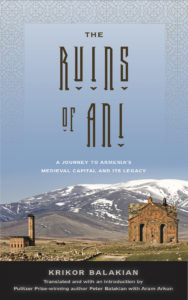 The Ruins of Ani
The Ruins of Ani
Krikor Balakian
Translated and with an introduction by Peter Balakian and Aram Arkun
New Brunswick, New Jersey: Rutgers University Press, 2019
pp.121.
The new edition of The Ruins of Ani by Rev. Fr. Krikor Balakian, who later became Bishop Grigoris Balakian, was originally published in Armenian by H. Matteosian Press in Constantinople in 1910. The Introduction was written by Professor Peter Balakian, who is a descendant of Bishop Balakian and a professor at Colgate University. He is the recipient of the Ralph Lemkin Price, the Pen/Albrand Award and the Pulitzer Prize for poetry. The English version of the book is dedicated to the memory of the Ani diggers including Nicholas Marr, Toros Toromanian, Hovsep Obeli, Arshak Fetvadjian and Aram and Artashes Vruyr.
Professor Balakian and scholar Aram Arkun together translated the book. Aram Arkun is the assistant editor of the Armenian Mirror-Spectator and the executive director of the Tekeyan Cultural Association. Professor Christina Maranci is a historian and researcher who contributed her expertise on the evolution of Armenian architecture to the book.
The Ruins of Ani is a travelogue and memoir of Reverend Fr. Krikor Balakian who visited the ruins of the historic Armenian city at the dawn of the twentieth century. Balakian was invited to make his pilgrimage by the Patriarch of All Armenians, His Holiness Catholicos Matteos II.
Ani was arguably the epicenter of the Armenian civilization and the accomplishments of the Armenian people. Rev. Balakian professed in his own words what Ani meant to him, writing “I was overjoyed at this opportunity to see Ani. I had a thirst to see the eternal monuments of the past glory of our forefathers. I wanted to kiss that holy soil.”
Peter Balakian captures the life and work of his great uncle and pays homage to the importance of his other memoir about the Armenian Genocide, titled the Armenian Golgotha, written circa 1918. Peter Balakian and scholar Aris Sevag translated the work for the English speaking world and published it in 2009. Rev. Fr. Balakian was elevated to Bishop of the Armenian Church of southern France after World War I. He was able to escape the genocide, but faced dangers through his exodus to freedom.
The scope of the new publication includes additional sections: “Notes on the Translation,” “Introduction” and “Description of Ani’s Ruins: Illustrated.” The “Introduction” is a vivid narrative with colorful illustrations and a wide range of Armenian historiography. He alludes to the work of Nicholas Marr, a noted Russian archaeologist who commenced the great dig at Ani in 1892, and was followed by other European and Armenian scholars who have also studied Ani and visited the region. Balakian refers to the historic significance of Ani with the main Cathedral, churches and institutions.
Although Ani is referred to as the “City of 1001 Churches,” Peter Balakian says that it is not the number of churches, but the emblematic emotional attachment Armenians have to the historic city that once was there. In contemporary Turkey, there are signs in areas where former Armenian churches once stood, but no signs indicating the presence of the kingdom of Armenia or its population. More than a 100 years after the Armenian Genocide, the blatant denial by the modern Turkish government leaves a blemish on its relationship with other nations worldwide. Its concealment of any wrongdoing is a form of “historicide.” As a matter of fact, the truth is revealed for travelers to the area; although no sign indicates the word “Armenia,” there is mention of the existence of a city called Ani. Peter Balakian writes, “The Armenian gaze on these sites is, in some way, inextricable from the event of the Genocide and the continuous denial by successive Turkish governments. The taboo and falsified status of vanishing Armenian ruins inside Turkey remain a material emblem of an unresolved, traumatic history.”
Balakian describes the journey taken to Ani by Rev. Fr. K. Balakian. He refers to Ani’s “topography and landscape” in spring 1909. Balakian also discusses the pre-genocidal events of the late nineteenth century referred to as the Hamidian Massacres against a sizable portion of the Armenian population and leading to the Armenian Genocide of 1915 carried out by the Young Turks.
Marr’s archaeology work was interrupted by World War I when the Russian and Ottoman forces clashed over territory in the midst of the Russian Revolution. The Ottoman Empire was defeated in World War I, but succeeded in usurping Ani. By 1921, Kazim Karabekir, a Turkish general, was commanded by Kemal “Ataturk” to obliterate Ani. The historic significance of the city, with its Cathedral and over a thousand churches and monuments, is etched in the memory of the Armenian legacy.
The pre-genocidal events of the late nineteenth century, including the Hamidian Massacres, were warnings of the next steps taken by the Turkish regime of the C.U.P. (Committee of Union & Progress), led by the Young Turk triumvirate. Balakian writes about events to benefit readers who may be unfamiliar with the destruction of the Armenian people in a nation where they were the most loyal and productive minority. He says that most Holocaust and genocide scholars have documented the Armenian Genocide as the “seminal event” in the longevity of genocides in contemporary times. He explains Adolf Hitler’s famous quote to his adjutants in 1939, “Who, today, after all, speaks of the annihilation of the Armenians?” He spoke these words when he ordered the killing of the Polish and Jewish people, illustrating how history repeated itself nearly twenty-five years after the Armenian Genocide.
In the new edition, the Armenian Genocide is depicted as the paradigm of other genocides that followed. The events leading to the Genocide of 1915 were also the prelude to Reverend Balakian’s personal plight in deceiving a regime intent on killing Armenians which started with the mass murders of intellectuals and clergy members. Later, it developed into the annihilation of an entire people regardless of their status. Balakian writes of the policy of denial promulgated by every Turkish regime since the end of World War I and that throughout his travels to the ruins of Ani and elsewhere in the region, the word “Armenia” is not mentioned at all. The current situation remains bleak since Turkish law prevents the teaching of the Armenian Genocide. There is no mention of the past contributions of the Armenian population that once inhabited the lands of its ancient kingdom. From time to time, the international community of nations calls for the restoration of Armenian and Christian churches.
In the chapter on history, the author discusses the founding of Ani and the early dynasties. The well-known Bagratuni (Pakraduni) Dynasty founded Ani near the Silk Road in circa 950 C.E. The author’s narrative about how a Seljuk leader usurped Armenia and successfully replaced Persian royalty was informative. The saga of Ani also includes details of the invasions of Ani by other civilizations who captured, destroyed and inhabited its environs.
The “Description of the Ruins of Ani” chapter is of particular erudition. The photos in Rev. Balakian’s book are in black and white, unlike those in Peter Balakian’s Introduction which are in vivid color. Fr. Balakian discusses various sanctuaries and explains the origin, design and geographical location of many. His descriptions bring to life the civilization of thriving Armenian communities and their religiosity. He guides the reader through the history of Ani and its multitude of churches. He also explains his emotional response to several sanctuaries and ruins, writing “It is impossible to see the extent of these ruins of Ani and not be touched or not to weep. How could the Armenian visitor not be moved and not shed tears, especially when he recalls that there was a time when this city was full of commotion and vitality that was a part of this great city… .”
The chapter “Scholarship on Ani” is praiseworthy and revealing. Rev. Balakian explains the Armenian style of architecture and the Persian and Arabic influences. He also notes the Romanesque dome designs and perhaps a touch of Norman design styles. The chapter also includes a great deal of architectural history. The priest ends his travel memoir describing the joy and sorrow of how the city of Ani is still in “the heart of the Armenian people…”
Peter Balakian’s book explores both the ancient and modern versions of the city of Ani, unknown to many non-Armenians. The intertwined legacy of the Balakian family and their connection to a revered city provides a moving and enduring account of history.



Be the first to comment